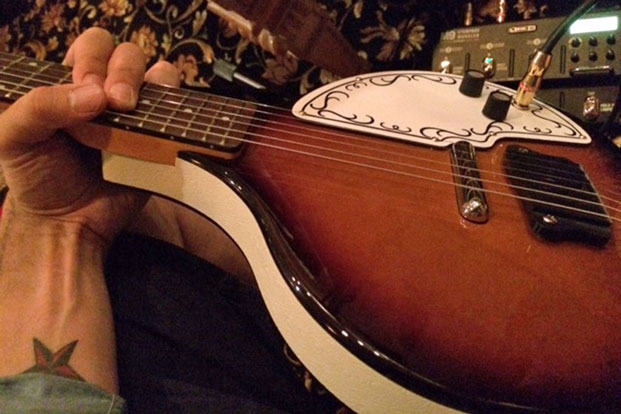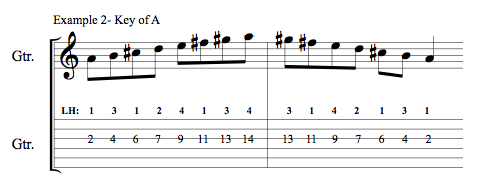Sitar- and Indian Mandolin-Style Linear Scales for Guitar

Taking techniques from different instruments and applying them to the guitar can open up a whole new approach to the instrument and add freshness to your playing and ideas.
In this lesson, we will look at approaching the guitar in the style of a sitar and Indian mandolin. A sitar has many strings (up to 20, to be exact). Ironically, out of all of these strings, most of the time only one of them is used to do the actual playing. The others are sympathetic and drone strings. A sitar player plays mostly in a linear fashion up and down on that one string.
As guitar players, we started out learning our scales in box shapes across the neck from E to E. Many players can play a scale from low E to high E at blinding speeds, but if you ask a lot of players to now play those scales only up and down on one string, they will probably not be able to play them quite as fast for two reasons. First, they don’t know the scales as well note-wise as they do finger-memory-wise.
Second, playing up and down on one string requires rapid position changes they might not be used to. In the following examples, two different ways are given to play these scales: picking, which is more of a sitar approach, and legato using slides, which is more of a Indian mandolin approach. The Indian mandolin isn't like the double-stringed, Western mandolin. It has six single strings like a guitar and is a little larger than the Western mandolin. You will often hear legato-type phrasing on this instrument.
In EXAMPLE 1, we have a scale in the key of D, starting on the root D on the G string in the middle of the neck. The scale descends to the fifth degree, A, jumps back to the root and ascends to the higher octave A, and then back down to the root D. Start out practicing the scale slowly. Focus on the position changes that occur between the fourth and fifth notes and the sixth and seventh notes on the ascent, and the third and fourth notes on the descent, and then finally the last note with the first finger, back to the starting point again with the fourth finger. Also, notice that sometimes you have to use the same finger to play two consecutive notes. Work on this transition as well.

In EXAMPLE 2, we have a scale in the key of A, starting on the root. This will take you from the low part of the neck straight up to the higher octave of the root with no adjacent fingers but more position changes.

Practice each of these scales, picking every note. After you are comfortable with the position shifts, try playing them legato. For the legato approach of EXAMPLE 1, pick only the first note, pulling off the rest and then sliding down to the notes that would use the same finger (B–A), and then slide up again to the root D with the first finger and hammer on the next note E. Then jump to the next position, picking the first note only and hammering on and pulling off the rest and finally slide from the 11th fret down to the ninth and start over again.
All the latest guitar news, interviews, lessons, reviews, deals and more, direct to your inbox!
The legato approach to EXAMPLE 2 would be to hammer on the first two notes (A-B) and then slide up to the next 2 (C#-D), pick the fifth note (E) with the first finger and hammer on to F#, slide up to G# and then A. To descend this scale, start with your fourth finger on A and pull off the next two notes, and then slide down from F# to E, then put your fourth finger again on D on the G string seventh fret, pulling off the next two notes and finally sliding down to the last two notes.
You will find that the legato approach gives you more of an Indian or slinky sound. Practice this very slowly so that it always sounds relaxed and comfortable. Eventually, practice these scales without having to look at the guitar neck. This is how sitar players are forced to play because of the size and positioning of the instrument. After you feel comfortable in these keys, try this approach in different keys and modes.
Steve Booke is a composer for film and TV from the New York area. His compositions range from orchestral to metal to world styles from every corner of the earth. A graduate of Berklee College of Music, Steve has played guitar for more than 27 years. He has recorded 10 albums of his own and has played on countless others. He plays gigs in the NY area and tours the East Coast with a variety of bands. He has performed with Ben E. King and members of Mahavishnu Orchestra. He endorses D'Addario/Planet Waves, Larrivee Guitars, Levy's Leathers, Peavey, Stylus Pick, Make Music, Pigtronix, Tech 21, Digitech, Graph Tech, Seymour Duncan, Waves, Studio Devil and L.R. Baggs. His music is available on iTunes and Amazon. He can be contacted at info@stevebooke.com. Visit stevebooke.com.
